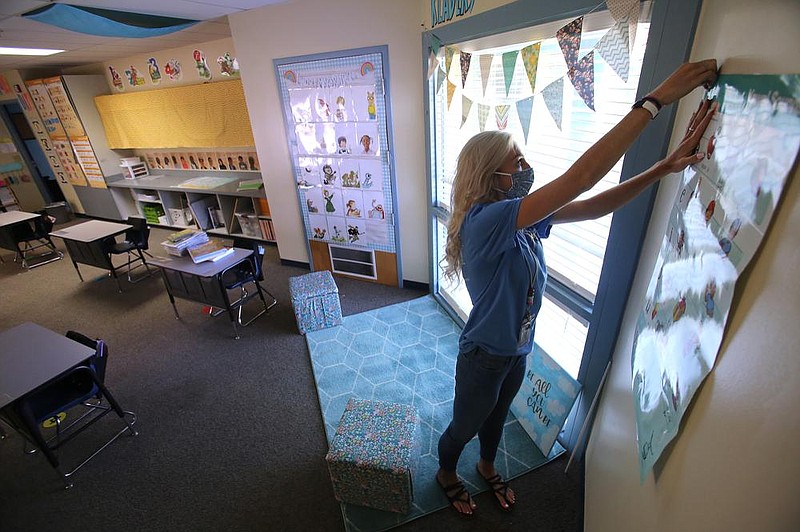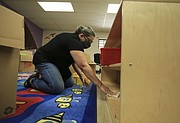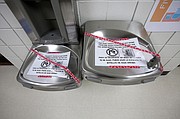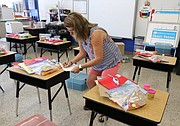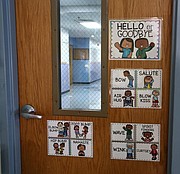Nupur Bhattacharyya doesn't understand why schools are open in the middle of a pandemic, but she knows she can't ensure that both of her young boys can keep up with virtual learning while she works.
The Little Rock mother plans to send her older son, Eshan, to Don Roberts Elementary School this week to start third grade. She'll supervise her kindergartner's virtual learning.
Bhattacharyya knows Eshan will learn better at school than he could online at home, but she's anxious. She went to the hospital twice last winter with influenza B and worries what would happen if she contracted covid-19.
This summer, Bhattacharyya faced the same crossroads that many other families have across the state. How does she resume her boys' educations while watching out for her family's health?
The Little Rock School District, like many across the state, is offering virtual and in-person options for the school year that starts Monday, but for parents like Bhattacharyya who must work during the school day, there wasn't much of a choice.
"We don't have an option," she said.
Most parents and guardians -- about 85%, according to Richard Abernathy, executive director of the Arkansas Association of Educational Administrators -- have made the same choice as Bhattacharyya. They're taking the health risk so that their children can have what they believe is a better learning experience or so the parents can work during the day.
Many families don't have internet at home for virtual learning or good enough cellular service to make a wireless hot spot work.
And the consequences of not holding class on campus can weigh on some families and children beyond education. School is often where lower-income children receive mental health services and free meals. It's also where educators and other staff members can spot children's needs, like hunger or whether the child is being abused.
Educators are mandatory reporters of child abuse, and the number of child abuse referrals to the Arkansas Division of Children and Family Services has dropped since schools closed in March, according to Arkansas Department of Human Services data analyzed by this newspaper. In April, 1,305 cases were referred to the division, compared with 2,751 in April 2019.
NOT LIKE BEFORE
On Monday, for the first time in more than five months, Arkansas' pre-kindergarten-through-12th-grade schools will open to students. Educators want the public to know one thing: School won't, and shouldn't, be anything like it was before.
In some schools, there will be no lockers and no drinking fountains.
The classrooms may have shower curtains that separate desks; a lot of desks will sit empty or be removed.
Everyone, or nearly everyone, will be asked to wear masks, and children will eat lunch in their classrooms or in the cafeteria, two chairs away from the nearest child.
These are some of the steps the state's public schools prepared for in-person learning during the novel coronavirus pandemic, which has struck the United States harder than it has most developed nations. The respiratory virus has a higher death rate than the flu -- killing nearly 675 Arkansans so far -- and can cause long-term lung and heart damage in those who survive it.
Educators have spent long hours preparing for virtual and in-person instruction. At the same time, they're developing contingency plans for what many consider to be inevitable: an outbreak and a return to full digital learning.
Exactly what would prompt a change in education delivery isn't clear. State officials haven't set numeric safety standards for cases per capita, although they recommend measuring the community spread of covid-19 to help guide education delivery. When asked what would prompt a return to all virtual learning, officials in many districts said it would be a directive from the state.
Already some districts have reported positive covid-19 cases during summer activities, and had students and staff members quarantine.
Many educators told the Arkansas Democrat-Gazette that their districts' safety precautions to be able to return to campus should be enough to prevent an outbreak, if everyone follows the rules.
Some educators and parents say they worry that people won't follow the plans or that schools can't possibly keep children 6 feet apart or prevent someone from carrying the virus to school.
Ryan Gray, a social studies and special-education teacher at Ramsey Junior High School in Fort Smith, is doubtful social distancing will be possible with well over half of the school's students returning for in-person instruction.
"All plans include the wording 'social distancing when possible,'" he said. "Everybody who works in a school building knows it's not possible.
"Districts don't have the facilities or the staff to reduce class sizes, and so the truth is class sizes are going to be exactly the same and social distancing is not going to be done. To me, that's the biggest thing they hear from teachers right now. They want parents to know and the district to be honest, and that is social distancing is not going to happen."
The school districts' plans rely heavily on parents and guardians screening their children before going to school each day. Some districts will screen each employee and are exploring how to daily screen students.
Some districts posted unofficial reopening plans online as early as July to gather feedback and give parents information to help them choose what kind of instruction they wanted for their children.
Many districts have two kinds of plans, called operational and support. The support plans are required by law, focus mostly on academics and must be posted on the district's website by Sept. 1. Those plans must address seven components required by the state aimed at overcoming the learning that students lost when classes ended in March, and at creating a healthy learning and communication environment going forward.
Operational plans are optional and contain details about everything else, including health precautions. Neither the state Health Department nor the state Education Department reviews operational plans.
APPROACHES PATCHWORK
Many districts developed plans to have in-person instruction only part of the week, but had to revise them after Gov. Asa Hutchinson and Education Secretary Johnny Key announced that districts must offer instruction on campus five days a week.
Written guidance that coincided with the announcement specified that districts could conduct three or four days of on-campus instruction and open schools the other days for instructional resources, interventions and therapy. All districts except those that operated on four-day weeks pre-pandemic must have their doors open five days each week.
The cost of reopening for face-to-face courses will be hundreds of thousands or even millions of dollars for some larger school districts in addition to typical operating expenses. Districts have told the newspaper that they've already spent more money on reopening than their share of federal Coronavirus Aid, Relief, and Economic Security (CARES) Act funding covers.
Under the CARES Act, Arkansas elementary and secondary schools received $128.8 million.
Before August, the Little Rock School District had already spent $5.7 million on pandemic-related purchases, according to data supplied to the newspaper. The district received $5.5 million in CARES Act funds.
School districts are tapping their savings to make purchases not covered by the federal funds, Abernathy said. Thankfully, he said, many can afford to do what they've had to so far.
Expenses are even higher at school districts trying to buy enough laptops to become "one-to-one" computer-access schools, meaning each student has his own school-issued laptop. For many, those plans were already in place, but the pandemic sped up the process to help students without computers at home keep pace while learning remotely.
Some districts are buying their own Wi-Fi hot spots or using those supplied by the state to extend internet access to families without it. Other districts expect parents and guardians who have chosen virtual learning to already have internet access.
Some, such as the Marion School District, where cell service for hot spots isn't reliable everywhere, provided parents a list of places in the community that have free Wi-Fi, including parking lots of schools and churches, Abernathy said.
Many school officials have expressed concern about the availability of cleaning and disinfecting supplies, and some have notified employees that shipments of some supplies are on back-order.
The Springdale School District gave teachers $20 to buy their own masks. Corrie Tucker, a first-grade teacher at Springdale's Young Elementary School, bought herself a face shield and cloth mask. She also had a friend who is a health care worker obtain several N95 masks -- the air-filtering coverings typically reserved for health care workers.
The N95 mask gives Tucker some peace of mind entering a school year in which many educators are anxious for their own health. Tucker noted that covid-19 test positivity rates in her part of the state are higher than health officials' goals and that some communities, such as Springdale's Marshallese population, have been disproportionately harmed by the virus.
[Video not showing up above? Click here to watch » https://www.youtube.com/watch?v=U7fsFr4KnOo]
"I have mixed emotions. A lot of our kids in Springdale just need to be with their teachers and just need to be in the classroom," she said, but the return to the classroom should happen when it's safe for everyone and teachers have the proper equipment.
Abernathy said school districts have struggled to allow teachers to work remotely, if they are at high risk of contracting severe covid-19 symptoms.
Teachers organizations have lamented the lack of teacher input in reopening plans. Carol Fleming, president of the Arkansas Education Association, and Michele Linch, executive director of the Arkansas State Teachers Association, said teachers feel left out.
"A lot of them are doing virtual and in-person instruction, which are two completely different types of planning and engaging with students," Linch said. "I will say, you know, they're doing the best they can."
Both leaders are also concerned about teachers' health and want more flexible leave options for those who feel vulnerable about their health, including teachers whose doctors have recommended that they work remotely.
Teachers are working hard, they said, and are concerned for their safety.
"They're reacting with a gamut of emotions right now," Fleming said. "Emotions are all over the scale. People are frightened. They're upset. They're confused. ... They're angry. They're feeling every emotion you can possibly feel with the reopening of schools."
Some districts with enough resources created one set of teachers for virtual learning and another for teaching in classrooms. At the Bryant School District, some teachers will teach only virtual students, but they must use district technology to teach their classes from the school building to ensure quality course delivery, spokeswoman Devin Sherill said.
The eStem Public Charter system doesn't have the resources to set up classes that way, Chief Executive Officer John Bacon said.
Most schools arranged for teachers to provide instruction for both in-person and virtual students.
STAFFING WORRIES
School districts may face challenges finding enough substitutes to cover classes when teachers must quarantine, Abernathy said. Arkansas and the nation have seen declining numbers of new teachers for several years, according to U.S. Department of Education data.
In Bryant, schools may use paraprofessionals to supervise classrooms if teachers have to quarantine, Sherill said.
The district's substitutes supplier, temporary employment firm Kelly Services, has already said the available substitute pool is smaller this year than last. The district has asked the company to assign a substitute to each elementary school, two for each middle school, and three for the junior high and high schools to reduce potential exposure and spread of the virus among schools and other districts.
The eStem district, which also uses Kelly Services, has also asked for designated substitutes.
The Arkansas Education Association, a professional teachers organization, has called for remote learning to start the school year, contending that the state isn't ready for in-person instruction. Members of the Little Rock Education Association teachers' union have voted to teach only virtually to start the school year.
Opponents of in-person instruction requirements have hosted a "die-in" and a mock funeral for teachers at the state Capitol.
The Arkansas Chapter of the American Academy of Pediatrics also has recommended against opening for in-person instruction, citing health risks.
The University of Arkansas for Medical Sciences has projected more new covid-19 infections by October under in-person or blended learning, compared with a relatively flat curve of new infections if schools remained online only.
A study published in the Journal of the American Medicine Association last month found that school closures this spring were associated with decreased covid-19 incidence and mortality nationally.
Earlier this month, the American Academy of Pediatrics and the Children's Hospital Association reported that 97,000 children tested positive for covid-19 in just the last two weeks of July.
Still, state officials have insisted that it's important to reopen schools to prevent students from falling further behind in their learning.
Across the nation, school districts have delayed start dates. Outside Arkansas, some districts that have already reopened remain open, but some have already transitioned to online-only education, or forced thousands of students, teachers and staff members to quarantine.
How successful school reopening is will depend on how detailed the plans are and how well they're followed, experts said.
In a recent call with education reporters, Dr. Tina Q. Tan, a pediatrics professor at Northwestern University's Feinberg School of Medicine, said all plans should require masks and social distancing, as well as contain a schedule for how often certain surfaces and bathrooms should be cleaned.
Outbreaks at some school districts so far, Tan said, have been related to high community transmission rates and districts not requiring social distancing or masks.
'AN INEVITABILITY'
Returning to school this fall has many parents on edge, regardless of the type of education they've chosen for their children.
Some say they chose virtual learning partly because of fear for their own health and partly to minimize the risk for families who had no choice but to send their children to school.
Bhattacharyya, the Little Rock mother, said the local covid-19 test positivity rate scares her.
"If it is not safe, why do you order to open school?" she said.
Still, she feels forced to send her son back because of the conflict between her job and the parental demands of online-only education.
"It's not possible," she said.
[COVID CLASSROOM: Read more stories from this series » arkansasonline.com/covidclassroom]
Tiffany Hadden originally planned to send her son, Connor, to Parkview High School in Little Rock for his sophomore year this fall. That changed when she discovered that not all of Connor's teammates were wearing masks during football practices a few weeks ago.
Then, a friend told her that if Connor was capable of remote learning he should do it to help reduce others' risk. She and her husband told their son that they'd changed their mind.
"He totally got it and thankfully didn't push back much," Hadden said. He has more concerns about keeping up with his extracurricular activities than he does about virtual learning, she said.
Hadden, and other parents who talked to the newspaper, hope virtual instruction will be better this semester than it was in the spring. Some said they felt assured that it would be better and more engaging, while also expressing frustration over having to make their decisions.
[CORONAVIRUS: Click here for our complete coverage » arkansasonline.com/coronavirus]
Veronica McClane, who has a second grader at Forest Heights STEM Academy in Little Rock, is fearful that kids won't wear masks and that teachers will have difficulty enforcing mask requirements. She chose virtual instruction for her child, who will learn alongside a few other children who use the same babysitter. The sitter has a degree in early childhood education, McClane said.
Lyuba Bogan, a parent of daughters who attend Roberts Elementary and Pinnacle View Middle School in Little Rock, said she's disappointed that political leaders and others didn't do more to curb the virus' spread earlier.
She and her husband, Martin, chose virtual learning for their two daughters, who will learn alongside a few peers whose parents will share in overseeing their educations. She believes schools will eventually close for in-person instruction, just like it did in the spring.
"It feels like an inevitability," she said.
